AMD's Radeon Software Crimson Driver Released: New Features & A New Look
by Ryan Smith & Daniel Williams on November 24, 2015 8:00 AM ESTUnder The Hood for Displays: Custom Resolutions, Freesync Improvements, & Framerate Target Control
Continuing our look into Crimson’s new features, AMD has also implemented some new & improved functionality specifically targeted at displays. The company has been more aggressive about display technologies and features since embarking on their Freesync project, and that is reflected in some of the changes made here.
Custom Resolution Support
First and foremost, AMD has finally (and at long last) implemented support for custom resolutions within their control panel. Custom resolution support is something of a niche feature – most users will never find it, let alone need it – however it’s extremely useful for those users who do need it. In our own case, for example, we use this feature with our Sharp PN-K321 4K monitor in order to run 1440p@60Hz on it, as the monitor doesn’t explicitly support that setting and Windows would rather upscale 1440p to 2160p@30Hz when left to its own devices.
Custom resolution support is another area where AMD is catching up with NVIDIA, as the latter has supported custom resolutions for several years now. In the meantime it’s been possible to use third-party utilities such as Custom Resolution Utility with AMD’s drivers to force the matter, but bringing support within AMD’s drivers is still a notable improvement.
AMD has never previously supported this feature in part due to the very low but nonetheless real risk of damage. If given video settings it can’t use, a properly behaving monitor should simply reject the input. However not all devices are perfect, and it is possible (however unlikely) that a monitor could damage itself trying to run with unsupported settings. This is why for both AMD and NVIDIA, custom resolutions come with a warning and are not covered under their respective warranties.
On a side note, one thing that was interesting to find was that this was one of the features not implemented in Radeon Settings. Rather the custom resolution control panel is part of the pared down Catalyst Control Center, now called Radeon Additional Settings. Considering that AMD never supported custom resolutions until now, it’s a bit surprising that they’d add it to CCC rather than Radeon Settings. But I suspect this has a lot to do with why CCC is still in use to begin with; that not all of the necessary monitor controls are available in Radeon Settings at this time.
Freesync Improvements: Low Framerate Compensation
With Omega AMD included initial support for Freesync, and now with Crimson AMD is rolling out some new Freesync functionality that changes how the technology works at the GPU level.
NVIDIA, never one to shy away from throwing barbs at the competition, has in the past called out AMD for how Freesync has handled minimum refresh rates. Specifically, that when the framerate falls below the minimum refresh rate of the monitor, Freesync setups would revert to non-Freesync operation, either locking into v-sync operation or traditional v-sync off style tearing depending on whether v-sync was enabled. Though in some ways better than what NVIDIA offered at the time (v-sync control) on the other hand it meant that the benefits of Freesync would be lost if the framerate fell below the minimum. Meanwhile NVIDIA, though not publishing exactly what they do, would seem to use some form of frame repeating in order to keep G-Sync active, repeating frames to keep variable refresh going rather than working at the minimum refresh rate.
This is something AMD appears to have taken to heart, and while they don’t specifically name NVIDIA in their presentation, all signs point to it being a reaction to NVIDIA’s barbs and marketing angle. As a result the Crimson driver introduces a new technology for Freesync which AMD is calling Low Framerate Compensation (LFC). LFC is designed to directly address what the GPU and Freesync monitor do when the framerate falls below the minimum refresh rate.
In AMD’s slide above, they list out the five refresh scenarios, and the two scenarios that LFC specifically applies to. So long as the framerate is above the minimum refresh rate, Freesync is unchanged. However when the framerate falls below the minimum, AMD has instituted a series of changes to reduce judder. Unfortunately, not unlike NVIDIA, AMD is treating this as a “secret sauce” and isn’t disclosing what exactly they’re doing to alleviate the issue. However based on what we’re seeing and AMD’s description (along with practical solutions to the problem), our best guess is that AMD is implementing frame repeating to keep the instantaneous refresh rate above the monitor’s minimum.
Frame reuse is simple in concept but tricky in execution. Not unlike CrossFire, there’s a strong element of prediction here, as the GPU needs to guess when the next frame may be ready so that it can set the appropriate refresh rate and repeat a frame the appropriate number of times. Hence, in one of the few things they do say about the technology, that AMD is implementing an “adaptive algorithm” to handle low framerate situations. Ultimately if AMD does this right, then it should reduce judder both when v-sync is enabled and when it is disabled, by aligning frame repeats and the refresh rate such that the next frame isn’t unnecessarily delayed.
The good news here is that this is a GPU-side change, so it doesn’t require any changes to existing monitors – they simply receive new variable refresh timings. However in revealing a bit more about the technology, AMD does note that LFC is only enabled with monitors that have a maximum refresh rate greater than or equal to 2.5 times the minimum refresh rate (e.g. 30Hz to 75Hz), as AMD needs a wide enough variable refresh range to run at a multiple of framerates right on the edge of the minimum (e.g. 45fps). This means LFC can’t be used with Freesync monitors that have a narrow refresh rate, such as the 48Hz to 75Hz models. Ultimately owners of those monitors don’t lose anything, but they also won’t gain anything with LFC.
As it stands we’ve only had a very limited amount of time to toy with Freesync on the new drivers, but what we’re seeing so far looks solid. But we’re definitely curious in seeing how daily Freesync users respond to this.
Finally, along with the LFC news, for the Crimson driver release AMD has offered a brief update on the status of Freesync-over-HDMI, reiterating that the company is still working on the technology. AMD first demonstrated the concept at Computex 2015 back in June, and while they still have a long way to go before it can make it into a retail product, the company continues to believe adaptive-synchronization is a viable and meaningful addition for HDMI.
Framerate Target Control: Wider Ranges
Back in June for the launch of the Radeon R9 Fury X, AMD introduced a new frame limiting feature called Framerate Target Control (FRTC). FRTC offered an alternative to v-sync, allowing users to cap the framerate of a game at an arbitrary framerate, selected via AMD’s control panel. While FRTC worked it had one unfortunate limitation, and that was that it only worked over a very limited range – 55fps to 95fps. Though this was sufficient to cap the framerate right below 60fps or directly above it, users have been asking for wider ranges to support higher framerate monitors or to limit a game to even lower framerates such as 30fps.
For Crimson AMD has gone ahead and widened the range of FRTC. It can now cap a game at between 30fps and 200fps, a range over four-times as wide. At the same time AMD has mentioned in our briefing that they’ve also done some additional work to better restrict GPU clockspeeds when FRTC is in use to maximize the power savings from using it to limit the amount of work the GPU does. Now the GPU will operate at a lower clockspeed more often, increasing the amount of power saved versus letting a video card run uncapped.


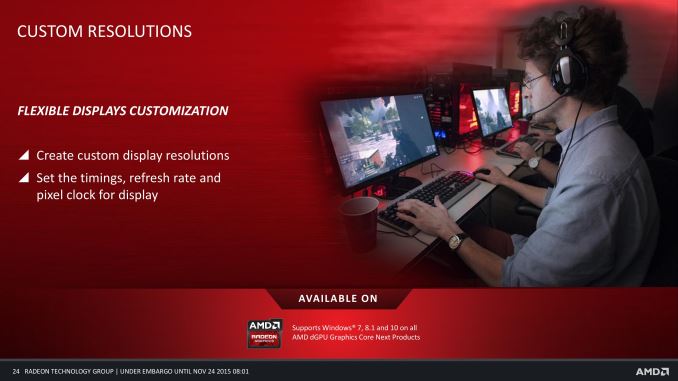
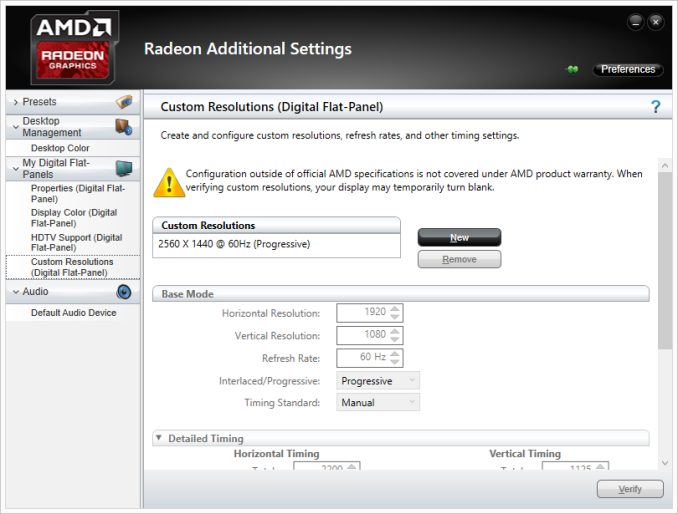
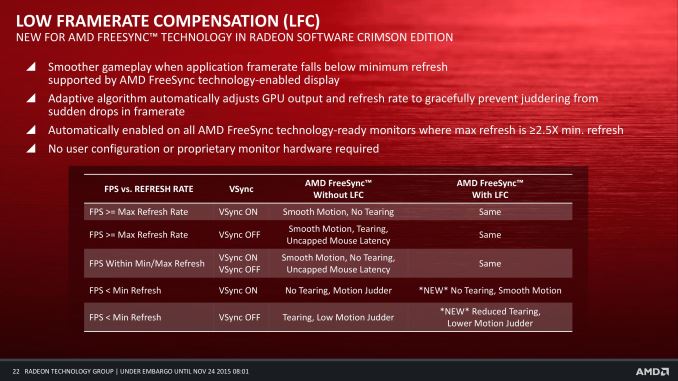
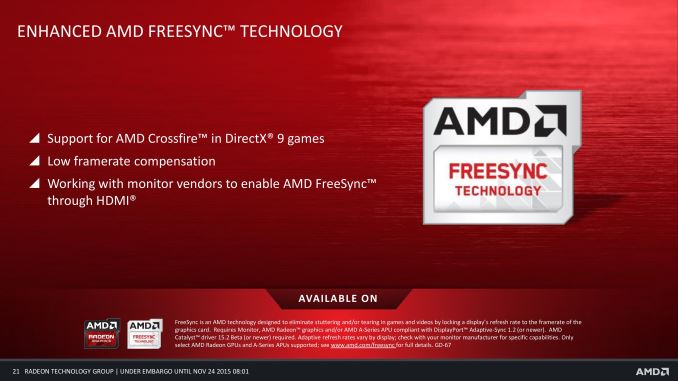
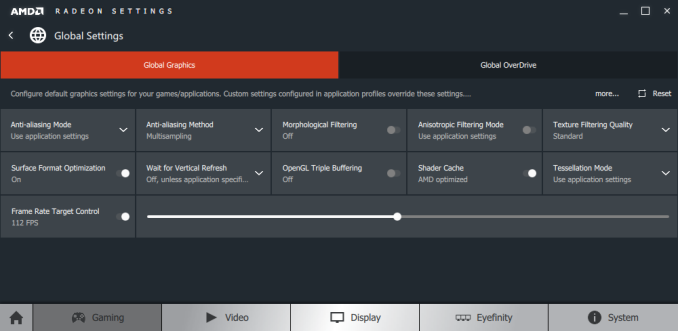









146 Comments
View All Comments
PixelBurst - Tuesday, November 24, 2015 - link
You seem to have fallen for Nvidia's trick of 'gameready' drivers. These aren't WHQL, these are beta drivers, they just don't say the word beta et Voila, users like yourself think they are doing God's work when they aren't.AS118 - Tuesday, November 24, 2015 - link
Yeah, that's just marketing spiel. If AMD called their beta drivers "cutting edge" or "performance optimized" drivers instead of "beta", I bet more people would try them and give them less flack for not making as many WHQL drivers.I've always said that Nvidia has had better marketing than AMD, and still think they do, which is why I think that even when performance and performance / value were equal or even if AMD was superior, that Nvidia always sold more.
I always try to tell AMD to up its marketing game as much as I can, as I don't want Nvidia to ever become a monopoly and I want the GPU and CPU races to stay competitive. I say this as a former Nvidia fanboy, who realized that no company is my friend and they all want my money, and that they'd probably misbehave if they'd ever become a monopoly. AMD too, but they're the underdog right now, which is why I support them lately. If they ever did become a monopoly or near-monopoly though, that'd change, of course.
jasonelmore - Tuesday, November 24, 2015 - link
Competition in the GPU Market drives Price CutsBut, I think Technology is pushing GPU Innovation and Performance.
VR and 4K alone are pushing GPU Engineers more than competition IMO
Dalamar6 - Wednesday, November 25, 2015 - link
Try getting an AMD card working in a rolling release linux distro like Arch, and then tell me that NVidia doesn't already have a monopoly.Oh wait, you can't. Not without having to disable what makes Arch, Arch, and using 9 months outdated software. And probably smashing a few keyboards/monitor/windows/glass objects/video cards in the process.
fluxtatic - Wednesday, November 25, 2015 - link
What is AMD's interest in getting drivers working in Arch? With the 5 billion Linux distributions out there, there are, what, a few thousand people that are really mad about this? AMD's not exactly what one would call "financially successful", so they're wise to pick their battles.looncraz - Wednesday, November 25, 2015 - link
Do it all the time, what's your problem?jasonelmore - Tuesday, November 24, 2015 - link
The drivers marked WHQL are all certified, i'm not sure what your saying.xenocea - Tuesday, November 24, 2015 - link
"Overall the average performance gain at 2560x1440 is just 1%. There are a couple of instances where there are small-but-consistent performance gains – Grand Theft Auto V and Grid: Autosport stand out here – but otherwise the performance in our other games is within the margin of error, plus or minus. Not that we were expecting anything different as this never was pitched as a golden driver, but this does make it clear that more significant performance gains are going be on a per-game basis."WCCF Tech performance test shows a different story.
"To quickly summarize the results that are below, Fiji see’s the largest increase in performance across all games tested, with between a 2-20% increase actually seen. This is actually astounding. But mostly, all tiers of card seem to have increased in performance, benefiting greatly from the new Crimson driver."
http://wccftech.com/amd-radeon-software-performanc...
nathanddrews - Tuesday, November 24, 2015 - link
PCPer tested the DX9 frame pacing fix for Skyrim and it showed an astounding improvement.http://www.pcper.com/files/imagecache/article_max_...
gamervivek - Tuesday, November 24, 2015 - link
wccftech's results look too good to be true with the BF4 results where they seem to be the only ones getting such a big increase. Either something is up with their setup or they're just making stuff up.